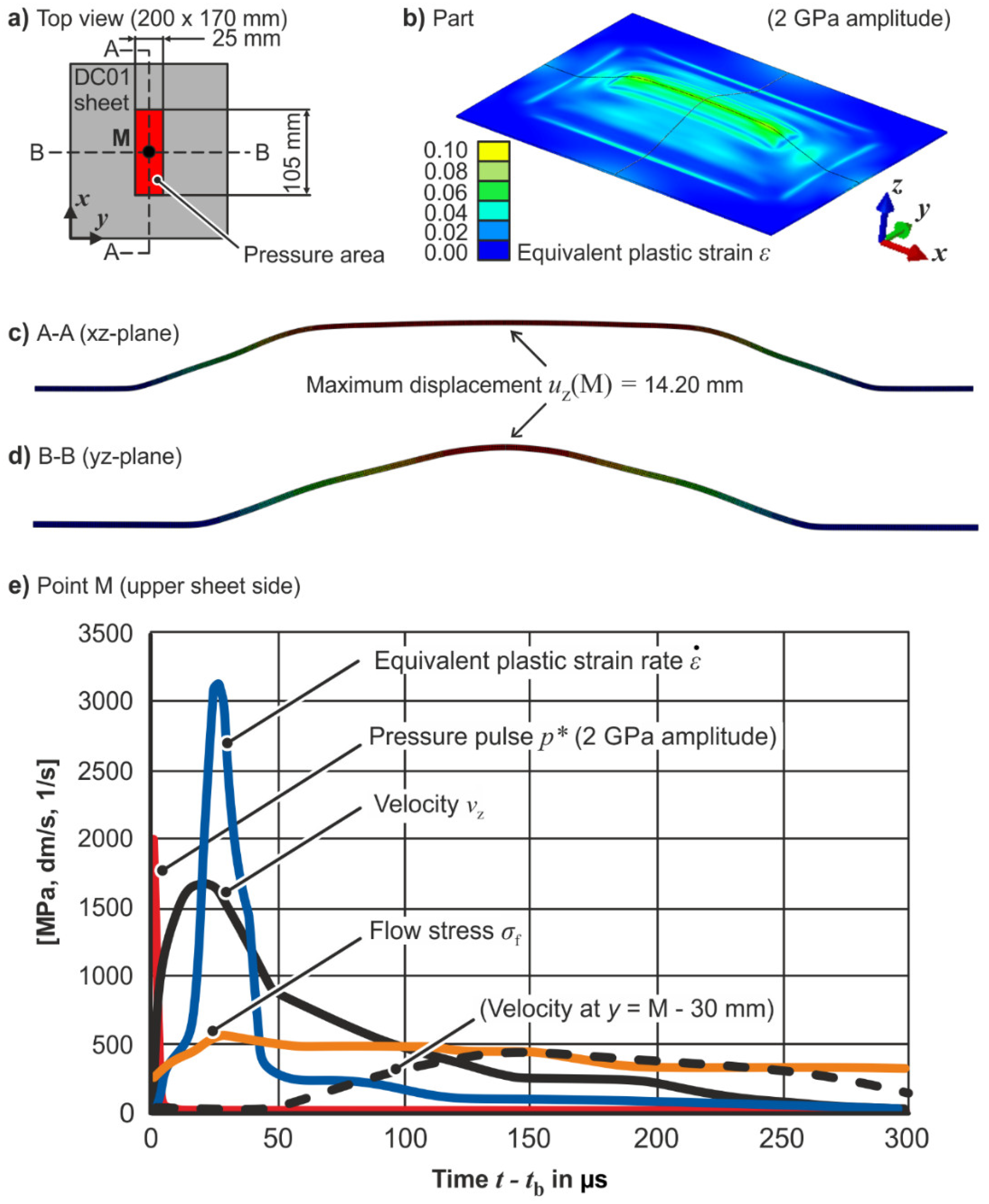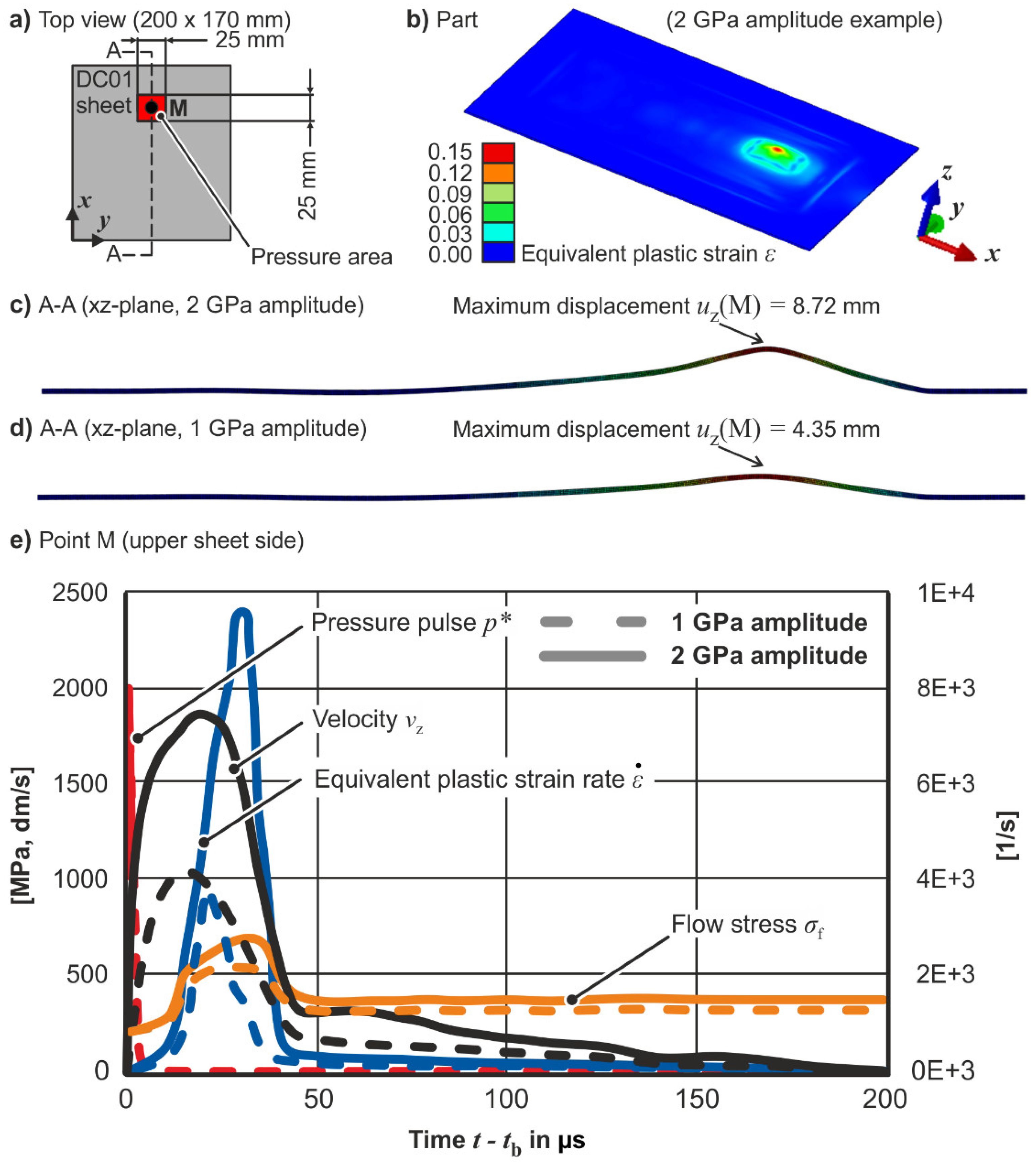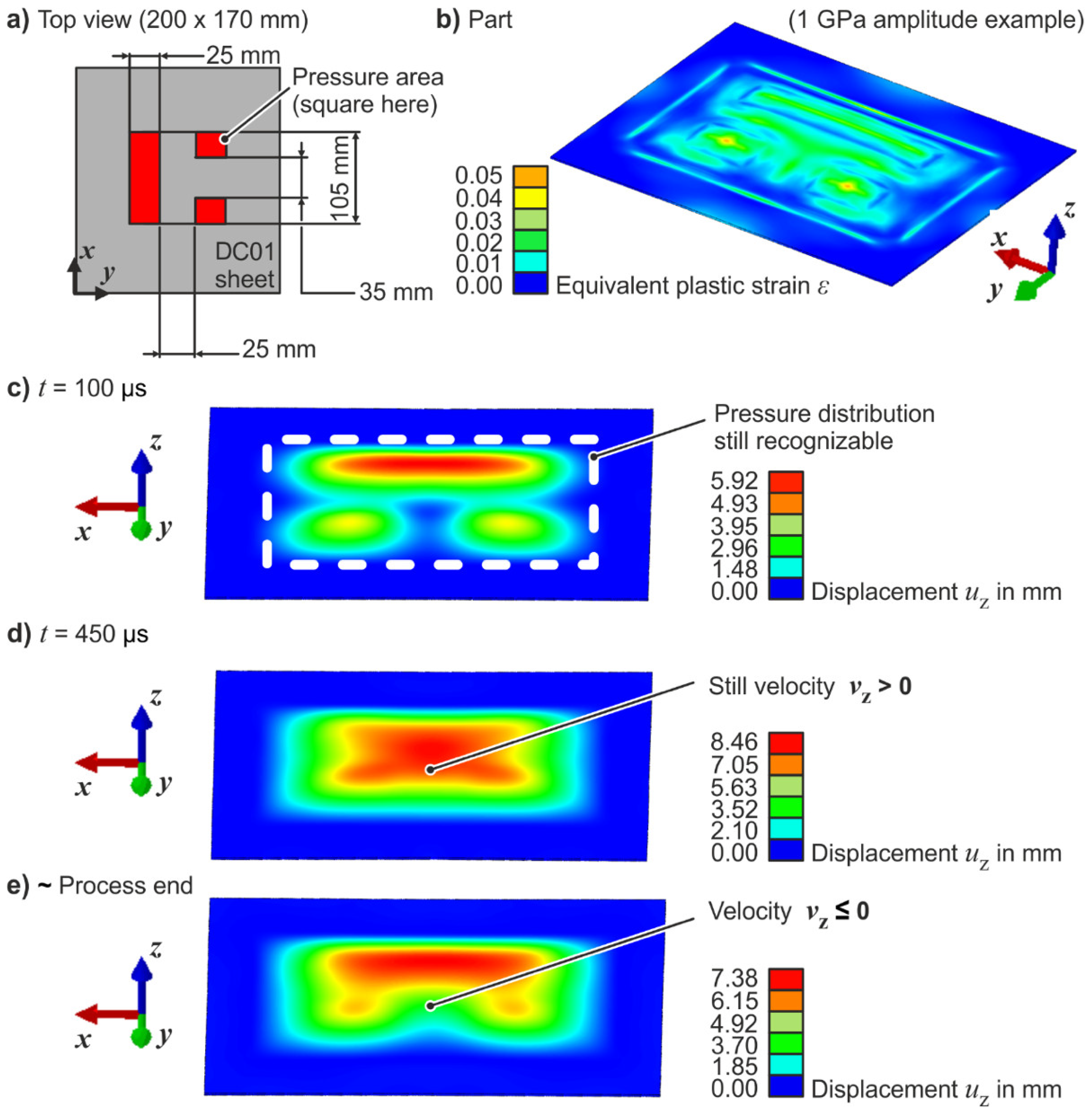Experimental and Numerical Analysis of the Influence of Burst Pressure Distribution on Rapid Free Sheet Forming by Vaporizing Foil Actuators
Abstract
1. Introduction
2. Materials and Methods
3. Results
3.1. Preliminary Experiments
3.2. Numerical Analysis of Various Pressure Distributions
4. Discussion
Author Contributions
Funding
Acknowledgments
Conflicts of Interest
References
- Vivek, A.; Taber, G.A.; Johnson, J.R.; Woodward, S.T.; Daehn, G.S. Electrically driven plasma via vaporization of metallic conductors: A tool for impulse metal working. J. Mater. Process. Technol. 2013, 213, 1311–1326. [Google Scholar] [CrossRef]
- Vivek, A.; Brune, R.C.; Hansen, S.R.; Daehn, G.S. Vaporizing foil actuator used for impulse forming and embossing of titanium and aluminum alloys. J. Mater. Process. Technol. 2014, 214, 865–875. [Google Scholar] [CrossRef]
- Vivek, A.; Hansen, S.R.; Liu, B.; Daehn, G.S. Vaporizing foil actuator: A tool for collision welding. J. Mater. Process. Technol. 2013, 213, 2304–2311. [Google Scholar] [CrossRef]
- Vivek, A.; Presley, M.; Flores, K.M.; Hutchinson, N.H.; Daehn, G.S. Solid state impact welding of BMG and copper by vaporizing foil actuator welding. Mater. Sci. Eng. 2015, 634, 14–19. [Google Scholar] [CrossRef]
- Hahn, M.; Weddeling, C.; Taber, G.; Vivek, A.; Daehn, G.S.; Tekkaya, A.E. Vaporizing foil actuator welding as a competing technology to magnetic pulse welding. J. Mater. Process. Technol. 2016, 230, 8–20. [Google Scholar] [CrossRef]
- Cai, S. Tailored pressure distributions generated by vaporizing tailored metal foils. Int. J. Adv. Manuf. Technol. 2018, 94, 2791–2801. [Google Scholar] [CrossRef]
- Wu, J.; Wang, L.; Li, Y.; Yang, L.; Sultan, M.; Chen, L. Characteristics of a plasma flow field produced by a metal array bridge foil explosion. Plasma Sci. Technol. 2018, 20, 075501. [Google Scholar] [CrossRef]
- Cai, S. Double-direction pressure distributions generated by vaporizing metal foils. J. Manuf. Sci. Eng. 2017, 139, 031006. [Google Scholar] [CrossRef]
- Grigoriev, A.N.; Pavlenko, A.V. Pressure generated by the electric explosion of metal foils. Tech. Phys. Lett. 2009, 35, 865–868. [Google Scholar] [CrossRef]
- Hahn, M.; Goyal, S.; Gies, S.; Tekkaya, A.E. Numerical modelling of energy deposition for vaporizing foil actuator forming. In Proceedings of the 13th International Conference on Numerical Methods in Industrial Forming Processes-NUMIFORM, Portsmouth, NH, USA, 23–27 June 2019. [Google Scholar]
- Hahn, M.; Hansen, S.R.; Gies, S.; Vivek, A.; Daehn, G.S.; Tekkaya, A.E. Prediction of achievable energy deposition for vaporizing foil actuators. In Proceedings of the 8th International Conference on High Speed Forming–CHSF, Columbus, OH, USA, 14–16 May 2018. [Google Scholar]
- Johnson, J.R.; Taber, G.; Vivek, A.; Zhang, Y.; Golowin, S.; Banik, K.; Fenton, G.; Daehn, G.S. Coupling experiment and simulation in electromagnetic forming using Photon Doppler Velocimetry. Steel Res. Int. 2009, 5, 359–365. [Google Scholar]
- Trzepiecinski, T. A study of the coefficient of friction in steel sheets forming. Metals 2019, 9, 988. [Google Scholar] [CrossRef]
- Lee, W.-S.; Liu, C.-Y. Dynamic compressive deformation behavior of S50C medium carbon steel. Mater. Sci. Technol. 2004, 20, 919–924. [Google Scholar] [CrossRef]
- Vivek, A.; Hansen, S.R.; Daehn, G.S. High strain rate metalworking with vaporizing foil actuator: Control of flyer velocity by varying input energy and foil thickness. Aip Rev. Sci. Instrum. 2014, 85, 075101. [Google Scholar] [CrossRef] [PubMed]
- Pegel, H.; Langstädtler, L.; Herrmann, M.; Schenk, C.; Kuhfuß, B. Electrohydraulic sheet metal forming with flexible tools. In Proceedings of the 5th International Conference on New Forming Technology–ICNFT, Bremen, Germany, 18–21 September 2018. [Google Scholar]







| Carbon (C) | Phosphorus (P) | Sulphur (S) | Manganese (Mn) |
|---|---|---|---|
| max. 0.12 | max. 0.045 | max. 0.045 | max. 0.6 |
| Y0 [MPa] | C1 [MPa] | C3 [1/K] | C4 [1/K] | C5 [MPa] | n [-] | |
|---|---|---|---|---|---|---|
| 165 | 656.48 | 0.0114 | 0.0006 | 359.11 | 0.3 | 0.002 |
© 2020 by the authors. Licensee MDPI, Basel, Switzerland. This article is an open access article distributed under the terms and conditions of the Creative Commons Attribution (CC BY) license (http://creativecommons.org/licenses/by/4.0/).
Share and Cite
Hahn, M.; Tekkaya, A.E. Experimental and Numerical Analysis of the Influence of Burst Pressure Distribution on Rapid Free Sheet Forming by Vaporizing Foil Actuators. Metals 2020, 10, 845. https://doi.org/10.3390/met10060845
Hahn M, Tekkaya AE. Experimental and Numerical Analysis of the Influence of Burst Pressure Distribution on Rapid Free Sheet Forming by Vaporizing Foil Actuators. Metals. 2020; 10(6):845. https://doi.org/10.3390/met10060845
Chicago/Turabian StyleHahn, Marlon, and A. Erman Tekkaya. 2020. "Experimental and Numerical Analysis of the Influence of Burst Pressure Distribution on Rapid Free Sheet Forming by Vaporizing Foil Actuators" Metals 10, no. 6: 845. https://doi.org/10.3390/met10060845
APA StyleHahn, M., & Tekkaya, A. E. (2020). Experimental and Numerical Analysis of the Influence of Burst Pressure Distribution on Rapid Free Sheet Forming by Vaporizing Foil Actuators. Metals, 10(6), 845. https://doi.org/10.3390/met10060845





